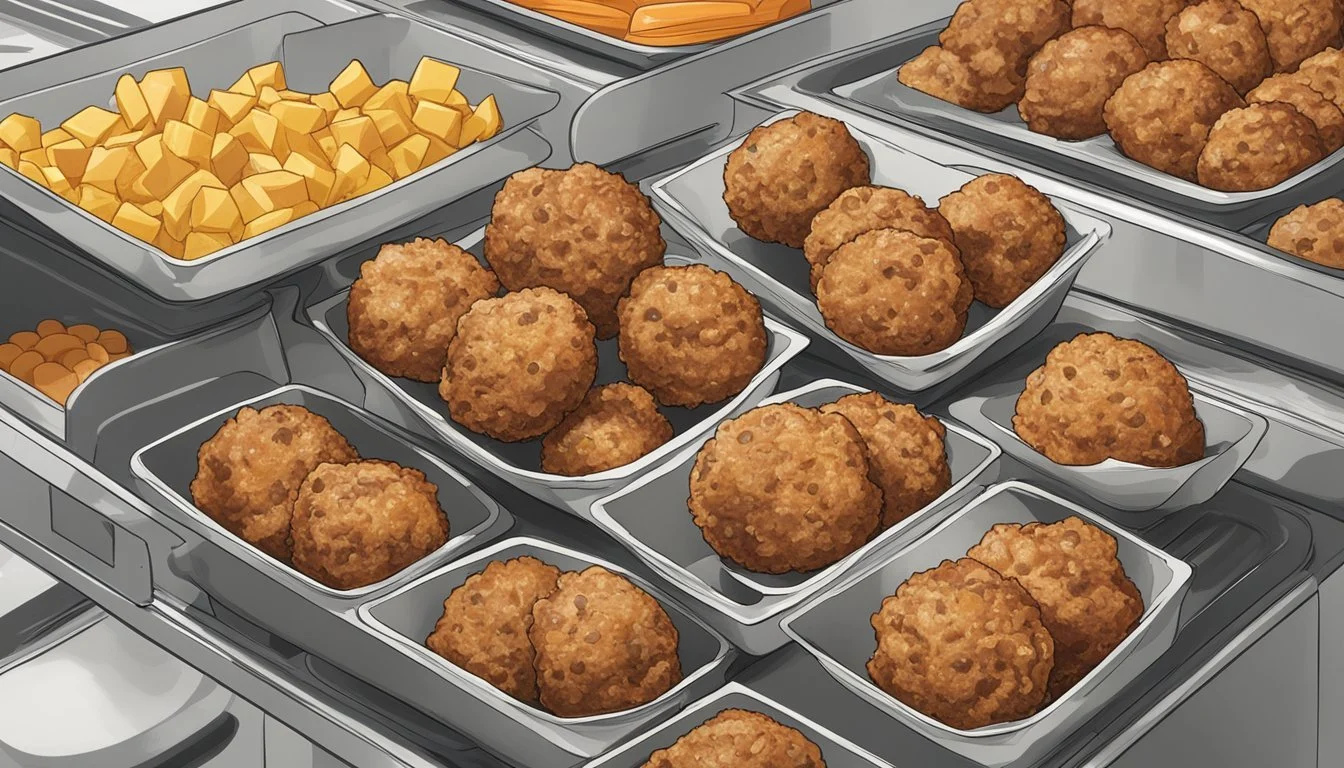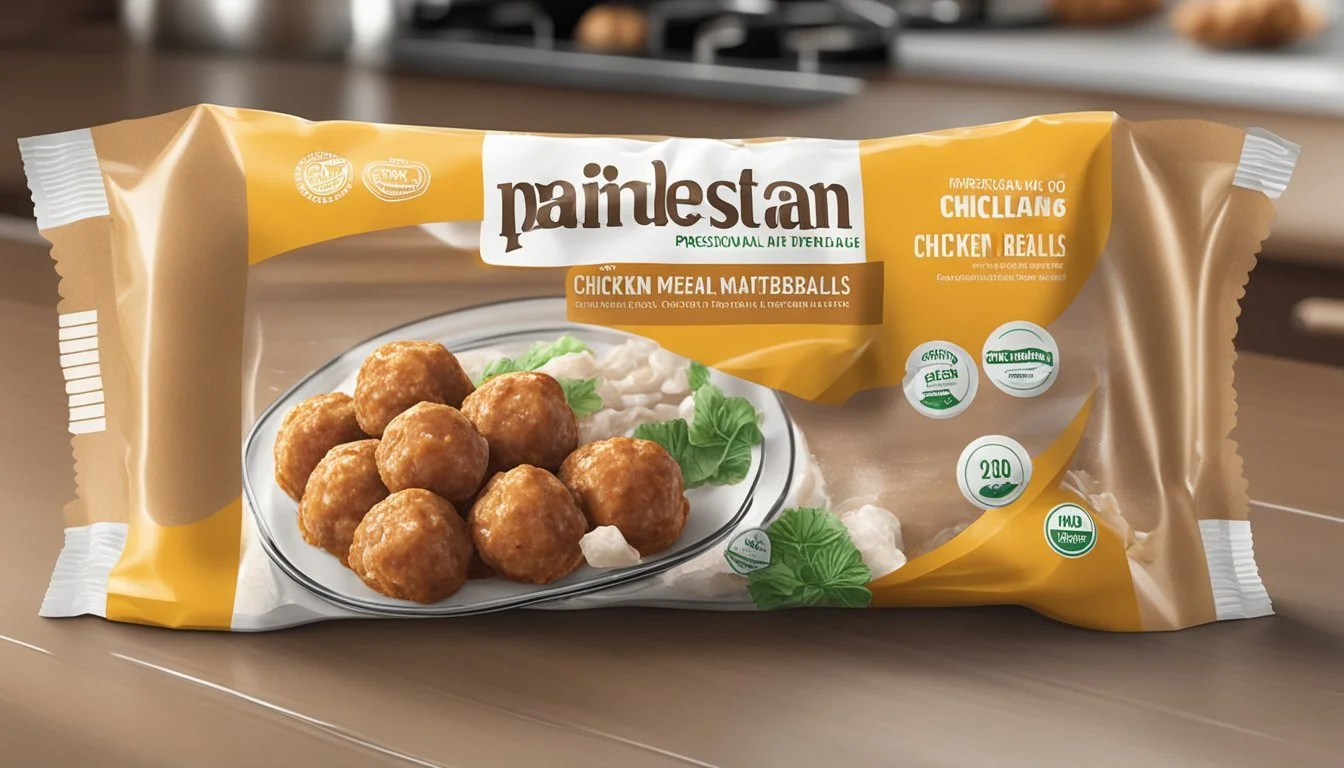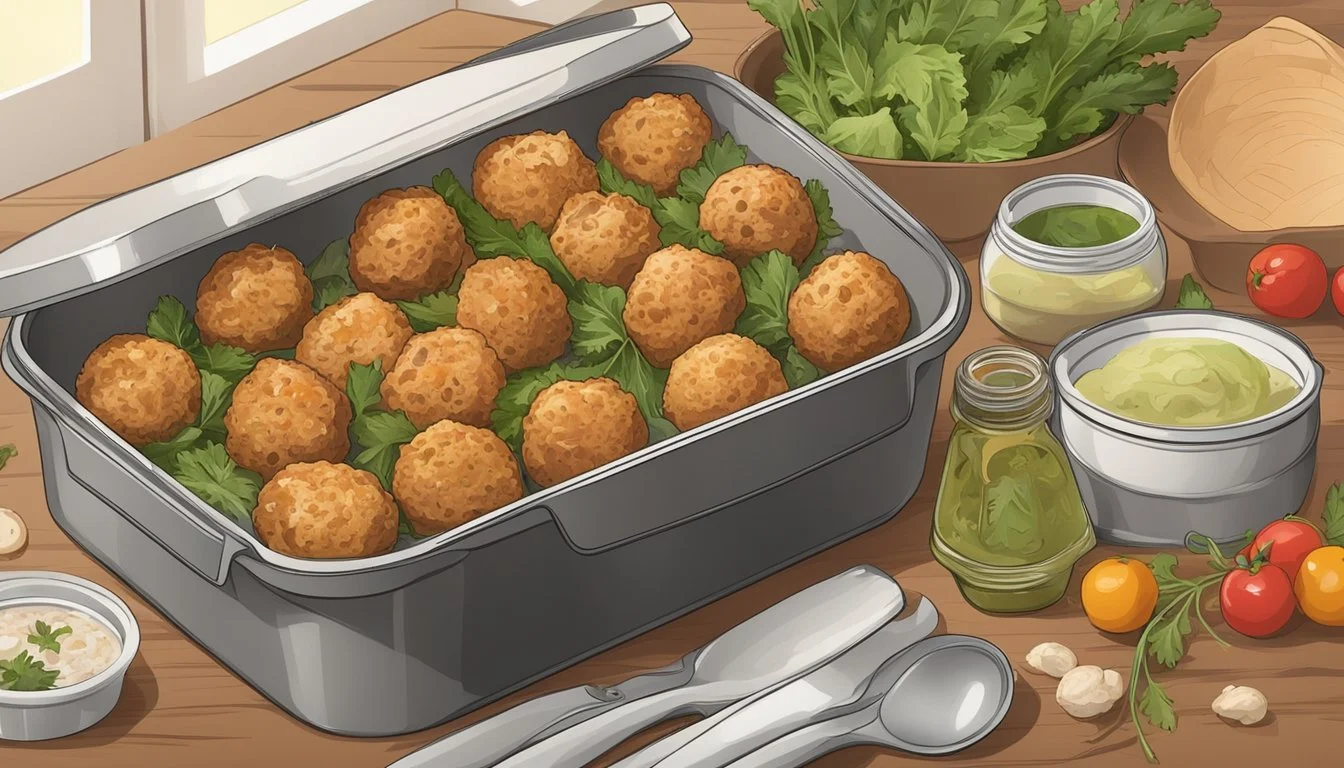How Long Do Chicken Meatballs Last?
Storage Tips and Safety Guide
Chicken meatballs are a versatile and protein-packed addition to many meals. Knowing how long they last can help ensure they remain safe and delicious to eat. Cooked chicken meatballs can be stored in the fridge for up to 3-4 days. For optimal storage, place them in an airtight container on the top shelf to maintain their freshness.
Incorporating them into your meal prep routine can save time and effort throughout the week. If you have more meatballs than you can consume within this timeframe, freezing is an excellent option. Frozen cooked chicken meatballs can last for 3-4 months when stored properly, making them a convenient choice for future meals.
Understanding Chicken Meatball Freshness
Chicken meatballs' freshness is essential for preserving their flavor and texture.
Raw meatballs can be kept in the refrigerator for 1-2 days. They should be placed in an airtight container to maintain quality.
Cooked meatballs last longer, typically 3-4 days in the fridge. They should also be stored in an airtight container at 40°F or below.
Signs of Spoilage
Smell: Off or sour odor
Appearance: Discoloration or unusual spots
Texture: Sticky or tacky feel
Freezing meatballs is another option to extend their freshness. Raw meatballs can be frozen for up to 3 months, while cooked meatballs can last up to 2 months.
Freezing Tips
Flash Freeze: Place meatballs on a baking sheet and freeze for 1-2 hours.
Storage: Transfer frozen meatballs into a freezer-safe bag or container.
Maintaining freshness ensures that chicken meatballs remain tender and flavor-packed. Proper storage methods help retain their quality and make them safe to consume.
Proper Storage Techniques
Proper storage of chicken meatballs is essential to ensure their safety and maintain their quality. Different methods are used for refrigerating and freezing, each requiring specific techniques to prevent spoilage and contamination.
Refrigerating Cooked Meatballs
Cooked chicken meatballs should be stored in an airtight container to retain their moisture and flavor. They should be placed on a shelf in the fridge at or below 40°F (4°C). It's crucial to store them away from raw meats to avoid cross-contamination.
Plastic wrap or aluminum foil can also be used to wrap the meatballs tightly before placing them in an airtight container. Properly store leftovers within 2 hours of cooking to reduce the risk of bacterial growth, and consume them within 3-4 days.
Freezing Chicken Meatballs
To freeze chicken meatballs, first allow them to cool completely. Place them in a freezer bag or an airtight container, ensuring minimal air inside to prevent freezer burn. Label the bag with the date for easy tracking.
The freezer should maintain a consistent temperature of 0°F (-18°C) or below. Chicken meatballs can safely remain in the freezer for up to 3-4 months. When ready to use, thaw them in the fridge overnight before reheating. Properly stored frozen meatballs will retain their taste and texture.
Shelf Life of Chicken Meatballs
Chicken meatballs have varying shelf lives depending on whether they are stored in the refrigerator or freezer. Proper storage conditions are crucial for maintaining their freshness and safety.
In the Refrigerator
Cooked chicken meatballs typically last for 3 to 4 days when stored in the refrigerator. They should be placed in an airtight container on the top shelf, maintaining a temperature of 40°F or below. Monitoring freshness by checking for signs of spoilage, such as an off smell or tacky texture, is essential to ensure safety.
Homemade chicken meatballs usually follow the same guidelines as store-bought ones. Raw chicken meatballs, however, should be consumed within 1-2 days of refrigeration. Always allow cooked meatballs to cool down to room temperature before refrigerating to prevent moisture buildup.
In the Freezer
For extended storage, placing chicken meatballs in the freezer is ideal. Cooked meatballs can last up to 2-3 months in the freezer, retaining their quality. To freeze, arrange them in a single layer on a baking sheet until solid and then transfer them to a freezer-safe bag or container. This method prevents them from sticking together.
Labeling the container with the date of freezing helps track their expiration. Raw chicken meatballs can also be frozen, lasting about 3-4 months while maintaining optimal quality. Using proper freezing techniques ensures they stay fresh and safe to eat.
Signs of Spoilage
Recognizing spoilage in chicken meatballs is essential to ensure food safety. Key indicators include visual/textural changes and off smells, which alert you to potential contamination and the risk of foodborne illness.
Visual and Textural Clues
Visual changes are among the first signs that chicken meatballs have gone bad. Look for any discoloration; fresh meatballs should have a uniform color. Spoilage might present as gray or greenish hues.
Texture is another critical factor. Spoiled meatballs often become slimy or sticky instead of maintaining a firm, smooth texture. A slimy surface is a clear indicator that bacteria have started to proliferate, and it is wise to discard the meatballs immediately.
Also, check for any mold growth. If you spot fuzziness or unusual spots, discard the meatballs to avoid the risk of harmful bacteria.
Olfactory Indicators
Olfactory cues are equally important when identifying spoiled chicken meatballs. Fresh meatballs should have a mild, pleasant meat smell. If you detect an off or sour smell, this suggests that the meatballs are no longer safe to eat.
A particularly pungent or ammonia-like odor indicates significant bacterial activity. Trust your nose; when in doubt, it’s better to discard the meatballs to prevent contamination and the risk of foodborne illness.
Pay attention to any other unusual smells. Chicken meatballs that have gone bad will have recognizable off odors, signaling that it's time to throw them out.
Thawing and Reheating
Thawing and reheating chicken meatballs properly is crucial for maintaining their quality and ensuring they are safe to eat. Key methods include using the refrigerator or cold water for thawing and various techniques for reheating to retain flavor and texture.
Safe Thawing Methods
To thaw chicken meatballs safely, avoid leaving them at room temperature as it can lead to bacterial growth. Instead, use the refrigerator. Place frozen meatballs in a sealed container or a zip-top bag and let them thaw overnight. This method keeps them at a safe temperature and prepares them for reheating.
For a quicker thawing option, use the cold water method. Submerge the sealed bag of meatballs in a bowl of cold water, changing the water every 30 minutes. This typically takes about 1-2 hours, depending on the quantity. Never use hot water as it can bring the outer layers to unsafe temperatures.
Reheating for Best Quality
When reheating chicken meatballs, achieving the right internal temperature is key. An oven is a reliable option. Preheat to 350°F (175°C). Place the meatballs on a baking sheet and heat for 12-18 minutes, ensuring they reach an internal temperature of 165°F (74°C). Cover with foil to retain moisture if needed.
Using a microwave can be quicker for smaller quantities. Place meatballs in a microwave-safe bowl, sprinkle with a little water, and cover with plastic wrap pierced to vent. Set the microwave to 50% power and heat in 30-second intervals. Check often to avoid overcooking.
For a stovetop method, reheat the meatballs in a pan over medium heat. If they were previously in sauce, add a bit of sauce to the pan and cover. Heat for 5-10 minutes, stirring occasionally until they are evenly warmed. This preserves both moisture and flavor, making them ideal for meal prep.
Safety Precautions
When preparing and storing chicken meatballs, maintaining food safety is crucial to avoid foodborne illnesses and ensure the food is safe to eat. Proper handling and cooking, as well as preventing cross-contamination, are key to successful kitchen practices.
Preventing Foodborne Illnesses
Foodborne illnesses often arise from improper handling and storage. Chicken meatballs should be stored in the refrigerator at or below 40°F (4°C) to slow bacterial growth.
Contamination can occur if raw meat comes into contact with ready-to-eat foods. To reduce this risk, use separate cutting boards and utensils for raw chicken and other foods. Always wash hands and surfaces thoroughly after touching raw meat.
Promptly refrigerate any leftover meatballs. Cooked meatballs can be stored in the fridge for up to 3-4 days. When reheating, ensure they reach an internal temperature of 165°F (74°C) using a food thermometer.
Proper Handling and Cooking
When handling raw chicken, always keep meat separate from other ingredients to avoid cross-contamination. Use gloves or wash hands frequently during preparation. Cooking chicken meatballs correctly is vital; they should be cooked in a preheated oven at 375°F (190°C) for 20-25 minutes.
A meat thermometer is essential in checking that the internal temperature reaches 165°F (74°C). This temperature ensures the meatballs are safe to eat and helps prevent food poisoning.
If freezing, use airtight containers or freezer bags with minimal air inside. This method can keep meatballs safe for up to 3-4 months. Label and date containers to keep track of storage time. Always thaw gently, preferably in the refrigerator, before reheating to ensure an even and safe temperature throughout.
Maximizing Meatball Quality
Ensuring your chicken meatballs remain fresh and full of flavor involves proper storage techniques. Using the right methods, such as airtight containers and careful freezing, can maintain their quality and texture.
Freezer Storage Tips
Freezing chicken meatballs correctly is crucial for maintaining their quality. Place the meatballs in airtight containers or high-quality freezer bags. Ensure minimal air is inside to prevent freezer burn, which can affect flavor and texture.
Label containers with the date of freezing. This helps in keeping track of how long they’ve been stored. Chicken meatballs can be frozen for up to three to four months while retaining their best quality.
For meal prepping, divide meatballs into portions before freezing. This makes it easier to thaw only what is needed, preserving the rest. To thaw, transfer meatballs from the freezer to the refrigerator overnight.
Maintaining Flavor and Texture
Maintaining the flavor and texture of chicken meatballs starts with storage. Airtight containers and freezer bags are essential in preventing moisture loss and freezer burn. Avoid using flimsy bags that may puncture easily, compromising meatball quality.
Reheat frozen or refrigerated meatballs gently to avoid drying them out. Use a microwave with a damp paper towel over the meatballs or reheat on a stovetop with a little broth.
Freshness plays a role in flavor. Consume refrigerated meatballs within 3-4 days. Frozen meatballs should be consumed within the suggested three to four months for optimal taste. Monitoring for signs of spoilage, like off smells or textures, is essential to ensuring meatballs are still good to eat.
Recipe Considerations
In preparing chicken meatballs, selecting the right ingredients and making appropriate cooking time adjustments are crucial for achieving a delicious and safe-to-eat meal.
Choosing Ingredients
When making chicken meatballs, ground chicken serves as the primary ingredient. It's important to use fresh ground chicken to ensure quality and taste.
Breadcrumbs are essential for binding the mixture, maintaining moisture, and giving the meatballs a nice texture. Parmesan cheese adds a rich flavor profile, while salt and black pepper help to season the meat to taste.
Incorporating an egg is crucial for binding the mixture, while garlic and onion provide a depth of flavor. Fresh parsley adds a bit of color and freshness, making the meatballs more appealing.
Cooking Time Adjustments
Adjusting cooking times is vital to ensure the meatballs are thoroughly cooked without drying out. Typically, chicken meatballs are baked at 400°F (200°C). Oven baking is common, with recommended times ranging from 12 to 15 minutes.
Whether baking or pan-frying, the meatballs should reach an internal temperature of 165°F (74°C). Using an instant-read thermometer can help ensure accuracy.
Pan-frying may require turning the meatballs every minute or so to achieve even browning. This method usually takes 10 to 12 minutes. Monitoring the meatballs as they cook helps in obtaining the perfect texture and flavor.
Ensuring proper cooking times and methods are adhered to helps maintain the safety and quality of the chicken meatballs, making them enjoyable and safe for consumption.
Serving and Presentation
Chicken meatballs can be a starring item in various dishes, both as appetizers and main courses. They pair excellently with a variety of sauces and accompaniments to enhance their flavor and presentation.
Appetizer and Meal Ideas
Chicken meatballs are versatile and can be presented elegantly as appetizers. Serve them on skewers with cherry tomatoes and fresh basil for a simple yet appealing party snack. They can also be neatly arranged on a platter with toothpicks for easy picking.
For main course ideas, pair chicken meatballs with pasta and marinara sauce. This creates a hearty, protein-packed meal. Another option is incorporating them into casseroles with vegetables and cheese. This is an excellent choice for meal prep, providing a nutritious and complete dish that can be made ahead of time. Additionally, chicken meatballs can be served with a side salad or rice to make a balanced meal.
Sauce Pairings and Accompaniments
A variety of sauces highlights the flavor of chicken meatballs. Classic marinara or tomato-based sauces are popular choices, especially when served with pasta. For a creamy touch, consider alfredo or a light bechamel sauce.
Teriyaki or soy-based sauces offer an Asian twist, making the meatballs ideal for serving with steamed vegetables and jasmine rice. For appetizer settings, a tangy barbecue sauce or honey mustard provides a delightful contrast, turning the meatballs into a flavorful party snack. When considering accompaniments, think of fresh and vibrant sides like roasted vegetables, mixed greens, or garlic bread to complement the flavors. Using different sauces and sides can elevate simple chicken meatballs into a memorable and delicious dish.










